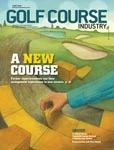Craig Currier, superintendent for Bethpage State Park, oversees agronomics for five golf courses within the 1,600-acre New York state park system. He’s readying the Black Course for its second U.S. Open Championship.
Q Are there any preparation differences between 2002 and 2009?
A The one thing that affects the course is the amount of public play received – 250 rounds per day in season. Our greens are 80 percent Poa, so to be able to handle the traffic, get ready for the event and be healthy enough to withstand the impacts from anthracnose and drought stress gets tricky. We’re on a regular, spoon-feeding liquid fertility program. We use 1/10 of a pound of nitrogen per week, combined with a micronutrient package and supplemented with humic acid and separate calcium applications to make the turf healthy and strong. The course is also on a weekly growth-regulation program.
One of the benefits this year is that the course will close to public play on June 1, allowing us ample time to coordinate our on-course work and volunteer schedules, keep track of final off-course operations and set-up and fix ball marks and divots. We also check and monitor isolated dry spots on putting greens so we can have proper moisture content and firmness. To respond to the stress and wilt caused by foot traffic, we hand-water and closely monitor irrigation. Finally, we protect chosen hole locations for the U.S. Open so there are no old hole plugs, scars or wear from traffic.
Our greens are slightly bowl shaped and we’ve drilled and filled our greens four times in the past two years to improve water infiltration. This practice is done in conjunction with weekly sand topdressing and hand-broomed to backfill any hole or groove created.
What’s really helped in the preparation is the closing of the Black Course on Mondays. This is key for us to conduct maintenance practices we couldn’t otherwise accomplish.
With a healthier plant, quality of cut on the putting greens is vital. We’re using the Jacobsen Eclipse mowers. The adjustable reel frequency designed into this unit has enhanced the quality of cut and will result in a more consistent, smoother ball roll.
It’s been challenging to comply with the state’s chemical application policies. We’ve been fortunate to have the insight and guidance of Dr. Frank Rossi of Cornell University to guide us through the process. As we are a state park and offer more than just golf, we have to be sensitive of other uses and visitors.
Q What are the changes in set-up between 2002 and 2009?
A The primary difference is the implementation of the USGA’s graduated rough philosophy. During the initial stages of the 1997 renovation, we overseeded fairways to perennial ryegrass. When the fairways were narrowed for the 2002 event, the outside edges became primary rough, with the turf density high and grown in at 6 to 8 inches. These conditions only afforded the contestants a sand wedge recovery shot.
Today, we have varying heights-of-cut between 2.5 and 4.5 inches. The density and health of the grass is similar to 2002, but we’ll have to mow daily during this championship to keep heights uniform. This will require more equipment, labor and coordination and more mowing, as the rope lines are set further back than in 2002.
Q What changes have been made to the course over the past seven years?
A We’ve added length to holes 3, 5, 7, 9, 12 and 13, going from 7,200 to about 7,500 yards. The two most prominent changes are on the 7th hole, where we took it from 480 to 525 yards (par 4) and the 13th hole, which was extended to 610 yards from its previous 555 yards (par 5).
Bunkers have been added to holes 4, 8 and 9. The ninth will really test the players off the tee. We deepened bunkers on the 10th and 11th holes, reshaped the cross bunker on 12, added and deepened bunkers on 13 and deepened the bunkers in the landing zone on 18.
Putting greens were expanded on two holes. On the par-3 eighth hole we slightly rolled the green over on the front edge to bring the pond more into play for shots that are short to a front hole location. On the par-3 14th hole, we added a back shelf, going from left to right, which will penalize a ball hit over the green by bringing the downslope into play. These changes add additional opportunities for hole locations, as well as shot options.
Q Do you have any concerns for this year?
A Of course, my biggest concern is weather, as rain and thunderstorms impacted us in 2002.
Q In 2002, you proposed to your wife. Any big plans for this year?
A No response... (Currier smiles). GCI

Explore the June 2009 Issue
Check out more from this issue and find your next story to read.
Latest from Golf Course Industry
- From the publisher’s pen: Conscientious of a bigger role
- Bernhard and Company partners with Laguna Golf Phuket
- Terre Blanche showcases environmental stewardship
- VIDEO: Introducing our December issue
- Bernhard and Company introduces Soil Scout
- Nu-Pipe donates to GCSAA Foundation’s Centennial Campaign
- GCSAA enhances golf course BMP tool
- Melrose leadership programs sending 18 to 2026 GCSAA Conference and Trade Show





